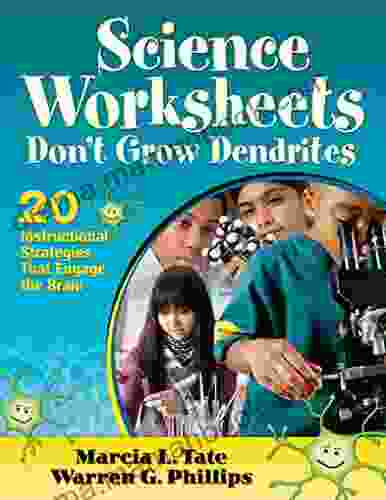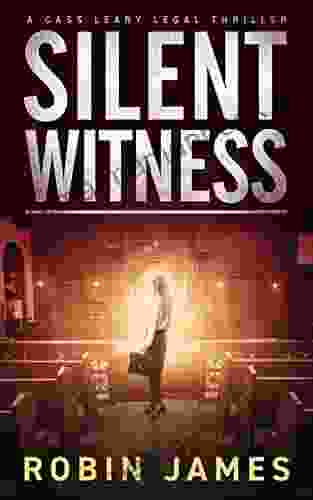20 Instructional Strategies That Engage The Brain: A Comprehensive Guide for Captivating Learners

In today's rapidly changing world, it is essential for students to develop the critical thinking skills, problem-solving abilities, and creativity they need to succeed. Traditional instructional strategies that focus on passive learning and rote memorization are no longer effective in engaging students and preparing them for the challenges of the 21st century.
This article presents 20 research-based instructional strategies that are designed to engage the brain and promote active learning. These strategies are organized into five categories: active learning, collaborative learning, technology integration, critical thinking, and metacognition.
4.3 out of 5
| Language | : | English |
| File size | : | 3767 KB |
| Text-to-Speech | : | Enabled |
| Enhanced typesetting | : | Enabled |
| Word Wise | : | Enabled |
| Print length | : | 194 pages |
| Lending | : | Enabled |
| Screen Reader | : | Supported |
Active Learning
Active learning is a teaching method that requires students to participate in the learning process. By actively engaging with the material, students are more likely to retain information and develop a deeper understanding of the subject matter.
- 1. Problem-Based Learning: This strategy involves presenting students with a real-world problem and having them work together to find solutions. Problem-based learning encourages students to develop critical thinking skills, problem-solving abilities, and communication skills.
- 2. Project-Based Learning: This strategy involves having students work on a long-term project that requires them to apply their knowledge and skills to a real-world problem. Project-based learning encourages students to develop critical thinking skills, problem-solving abilities, communication skills, and teamwork skills.
- 3. Cooperative Learning: This strategy involves having students work together in small groups to complete a task or project. Cooperative learning encourages students to develop communication skills, teamwork skills, and social skills.
- 4. Experiential Learning: This strategy involves having students learn by ng. Experiential learning can be used to teach a variety of subjects, such as science, math, and social studies.
- 5. Authentic Learning: This strategy involves having students learn by engaging in real-world activities. Authentic learning can be used to teach a variety of subjects, such as business, art, and social studies.
Collaborative Learning
Collaborative learning is a teaching method that encourages students to work together to achieve a common goal. By working together, students can learn from each other and develop a deeper understanding of the subject matter.
- 6. Peer Assessment: This strategy involves having students assess each other's work. Peer assessment encourages students to develop critical thinking skills, self-assessment skills, and communication skills.
- 7. Jigsaw: This strategy involves dividing students into groups and having each group learn about a different aspect of a topic. The groups then come together and share their knowledge with each other.
- 8. Group Projects: This strategy involves having students work together in groups to complete a project. Group projects encourage students to develop communication skills, teamwork skills, and problem-solving skills.
- 9. Think-Pair-Share: This strategy involves having students think about a question or problem individually, then pair up to share their ideas, and finally share their ideas with the class.
- 10. Socratic Seminar: This strategy involves having students discuss a topic in a structured and respectful manner. Socratic seminars encourage students to develop critical thinking skills, communication skills, and listening skills.
Technology Integration
Technology can be a powerful tool for engaging students and promoting active learning. However, it is important to use technology in a way that is meaningful and effective.
- 11. Flipped Classroom: This strategy involves having students watch video lectures at home and then use class time to work on problems and activities. The flipped classroom allows students to learn at their own pace and gives them more time to practice what they are learning.
- 12. Simulation: This strategy involves using a computer model or game to create a realistic learning environment. Simulations can be used to teach a variety of subjects, such as science, math, and social studies.
- 13. Gaming: This strategy involves using games to teach a variety of subjects. Games can be used to engage students and make learning more fun.
- 14. Social Media: This strategy involves using social media to engage students and promote learning. Social media can be used to create online communities, share resources, and facilitate discussions.
- 15. Augmented Reality: This strategy involves using augmented reality to create an interactive learning environment. Augmented reality can be used to overlay digital information onto the real world.
Critical Thinking
Critical thinking is the ability to think clearly and rationally about what to do or what to believe. Critical thinking skills are essential for success in school, work, and life.
- 16. Questioning: This strategy involves asking students questions to help them think more deeply about the subject matter. Questioning can be used to check for understanding, to encourage students to think critically, and to facilitate discussions.
- 17. Socratic Method: This strategy involves asking students a series of questions to help them reach a deeper understanding of the subject matter. The Socratic method can be used to teach a variety of subjects, such as philosophy, literature, and history.
- 18. Debating: This strategy involves having students debate a topic in a structured and respectful manner. Debating encourages students to develop critical thinking skills, communication skills, and listening skills.
- 19. Inquiry-Based Learning: This strategy involves having students investigate a topic and come to their own s. Inquiry-based learning encourages students to develop critical thinking skills, problem-solving abilities, and communication skills.
- 20. Concept Mapping: This strategy involves creating a visual representation of a concept. Concept mapping can be used to help students understand complex relationships and to organize their thoughts.
Metacognition
Metacognition is the ability to think about your own thinking. Metacognitive skills are essential for success in school, work, and life. Metacognitive strategies help students to become more aware of their own learning process and to take control of their learning.
- 21. Reflection: This strategy involves having students reflect on their own learning. Reflection can be used to help students identify their strengths and weaknesses, to set goals, and to develop learning strategies.
- 22. Self-Assessment: This strategy involves having students assess their own work. Self-assessment can help students to develop critical thinking skills, self-assessment skills, and communication skills.
- 23. Goal Setting: This strategy involves having students set goals for their learning. Goal setting can help students to stay motivated and to track their progress.
- 24. Learning Strategies: This strategy involves teaching students how to learn effectively. Learning strategies can help students to develop critical thinking skills, problem-solving abilities, and communication skills.
- 25. Differentiation: This strategy involves tailoring instruction to meet the needs of individual students. Differentiation can help students to learn at their own pace and in a way that is most effective for them.
The instructional strategies presented in this article are just a few of the many ways to engage students and promote active learning. By using a variety of strategies, teachers can create a learning environment that is both effective and enjoyable.
When students are engaged in the learning process, they are more likely to retain information, develop critical thinking skills, and become lifelong learners.
4.3 out of 5
| Language | : | English |
| File size | : | 3767 KB |
| Text-to-Speech | : | Enabled |
| Enhanced typesetting | : | Enabled |
| Word Wise | : | Enabled |
| Print length | : | 194 pages |
| Lending | : | Enabled |
| Screen Reader | : | Supported |
Do you want to contribute by writing guest posts on this blog?
Please contact us and send us a resume of previous articles that you have written.
 Top Book
Top Book Novel
Novel Fiction
Fiction Nonfiction
Nonfiction Literature
Literature Paperback
Paperback Hardcover
Hardcover E-book
E-book Audiobook
Audiobook Bestseller
Bestseller Classic
Classic Mystery
Mystery Thriller
Thriller Romance
Romance Fantasy
Fantasy Science Fiction
Science Fiction Biography
Biography Memoir
Memoir Autobiography
Autobiography Poetry
Poetry Drama
Drama Historical Fiction
Historical Fiction Self-help
Self-help Young Adult
Young Adult Childrens Books
Childrens Books Graphic Novel
Graphic Novel Anthology
Anthology Series
Series Encyclopedia
Encyclopedia Reference
Reference Guidebook
Guidebook Textbook
Textbook Workbook
Workbook Journal
Journal Diary
Diary Manuscript
Manuscript Folio
Folio Pulp Fiction
Pulp Fiction Short Stories
Short Stories Fairy Tales
Fairy Tales Fables
Fables Mythology
Mythology Philosophy
Philosophy Religion
Religion Spirituality
Spirituality Essays
Essays Critique
Critique Commentary
Commentary Glossary
Glossary Bibliography
Bibliography Index
Index Table of Contents
Table of Contents Preface
Preface Introduction
Introduction Foreword
Foreword Afterword
Afterword Appendices
Appendices Annotations
Annotations Footnotes
Footnotes Epilogue
Epilogue Prologue
Prologue Anita Mathias
Anita Mathias Travis Wayne Goodsell
Travis Wayne Goodsell Amy Rasmussen
Amy Rasmussen Karla Gracey
Karla Gracey Thomas Lubben
Thomas Lubben W Winters
W Winters Martin Wolf
Martin Wolf Roshanta Lock
Roshanta Lock J S Armstrong
J S Armstrong James Patterson
James Patterson Michelle Terrell
Michelle Terrell Lexie Miers
Lexie Miers Bill Donahue
Bill Donahue Emma Goldrick
Emma Goldrick Trevor Pacelli
Trevor Pacelli Sean Campbell
Sean Campbell Glennon Doyle
Glennon Doyle Paul Remack
Paul Remack Richard M Ankers
Richard M Ankers Sara Bushway
Sara Bushway
Light bulbAdvertise smarter! Our strategic ad space ensures maximum exposure. Reserve your spot today!
 Scott ParkerFollow ·18.2k
Scott ParkerFollow ·18.2k Clarence BrooksFollow ·13.2k
Clarence BrooksFollow ·13.2k Jan MitchellFollow ·11.1k
Jan MitchellFollow ·11.1k Gary CoxFollow ·7.4k
Gary CoxFollow ·7.4k Eric HayesFollow ·16.6k
Eric HayesFollow ·16.6k Justin BellFollow ·9.2k
Justin BellFollow ·9.2k Christopher WoodsFollow ·16.6k
Christopher WoodsFollow ·16.6k Adrien BlairFollow ·18.7k
Adrien BlairFollow ·18.7k

 Jesus Mitchell
Jesus MitchellThe Diabetics Menu: Your Low Carb Options
If you're living with diabetes, you may be...

 Danny Simmons
Danny SimmonsThe Sam Reilly Collection: A Treasure Trove of...
In the realm of...

 Vic Parker
Vic ParkerThe Shepherdess of Siena: The Extraordinary Life of Saint...
Catherine of Siena, known as the...

 Christian Carter
Christian CarterDive into the Mystical World of Meraki Syren: A Literary...
A Literary Odyssey Through the Depths...

 Eric Hayes
Eric HayesSimplest Method on How to Remove Credit Cards from Your...
Do you have multiple credit cards...
4.3 out of 5
| Language | : | English |
| File size | : | 3767 KB |
| Text-to-Speech | : | Enabled |
| Enhanced typesetting | : | Enabled |
| Word Wise | : | Enabled |
| Print length | : | 194 pages |
| Lending | : | Enabled |
| Screen Reader | : | Supported |














